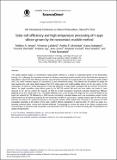Solar Cell Efficiency and High Temperature Processing of n-type Silicon Grown by the Noncontact Crucible Method
Author(s)
LaSalvia, Vincenzo; Morishige, Ashley E.; Nakajima, Kazuo; Veschetti, Yannick; Jay, Frederic; Jouini, Anis; Stradins, Paul; Jensen, Mallory Ann; Morishige, Ashley Elizabeth; Youssef, Amanda; Buonassisi, Anthony; ... Show more Show less
Download1-s2.0-S1876610216305021-main.pdf (497.6Kb)
PUBLISHER_CC
Publisher with Creative Commons License
Creative Commons Attribution
Terms of use
Metadata
Show full item recordAbstract
The capital expense (capex) of conventional crystal growth methods is a barrier to sustainable growth of the photovoltaic industry. It is challenging for innovative techniques to displace conventional growth methods due the low dislocation density and high lifetime required for high efficiency devices. One promising innovation in crystal growth is the noncontact crucible method (NOC-Si), which combines aspects of Czochralski (Cz) and conventional casting. This material has the potential to satisfy the dual requirements, with capex likely between that of Cz (high capex) and multicrystalline silicon (mc-Si, low capex). In this contribution, we observe a strong dependence of solar cell efficiency on ingot height, correlated with the evolution of swirl-like defects, for single crystalline n-type silicon grown by the NOC-Si method. We posit that these defects are similar to those observed in Cz, and we explore the response of NOC-Si to high temperature treatments including phosphorous diffusion gettering (PDG) and Tabula Rasa (TR). The highest lifetimes (2033 μs for the top of the ingot and 342 μs for the bottom of the ingot) are achieved for TR followed by a PDG process comprising a standard plateau and a low temperature anneal. Further improvements can be gained by tailoring the time-temperature profiles of each process. Lifetime analysis after the PDG process indicates the presence of a getterable impurity in the as-grown material, while analysis after TR points to the presence of oxide precipitates especially at the bottom of the ingot. Uniform lifetime degradation is observed after TR which we assign to a presently unknown defect. Future work includes additional TR processing to uncover the nature of this defect, microstructural characterization of suspected oxide precipitates, and optimization of the TR process to achieve the dual goals of high lifetime and spatial homogenization. Keywords: silicon; noncontact crucible; defect; swirl; lifetime; tabula rasa; gettering; capex
Date issued
2016-09Department
Massachusetts Institute of Technology. Department of Mechanical EngineeringJournal
Energy Procedia
Publisher
Elsevier BV
Citation
Jensen, Mallory A. et al. “Solar Cell Efficiency and High Temperature Processing of n-Type Silicon Grown by the Noncontact Crucible Method.” Energy Procedia 92 (August 2016): 815–821 © 2016 The Authors
Version: Final published version
ISSN
1876-6102